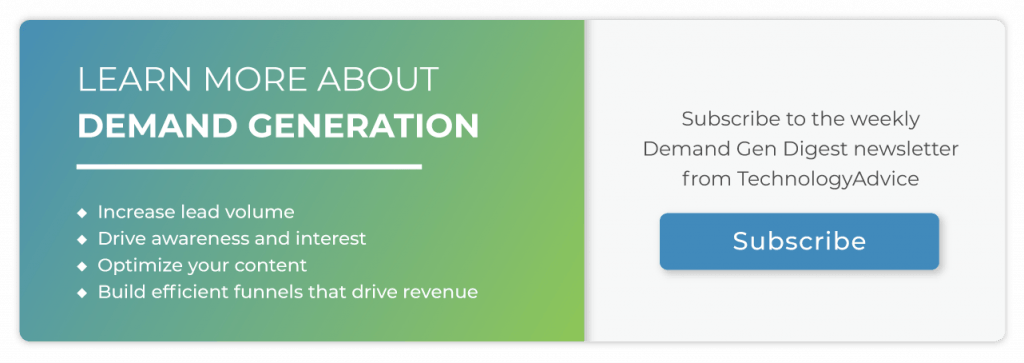As COVID-19 pushes many companies to move their events online, businesses are looking for ways to maintain event engagement and value while doing what’s best for public health. There are significant challenges in hosting virtual events — attendees are easily distracted, Zoom fatigue is a real thing, and many people just don’t have time with children home from school.
But shifting to on-demand, highly focused virtual events presents businesses with a good solution. Some marketers may still swoon for the big attendance numbers of webinars, but this can be more of a quantity over quality approach. By contrast, niche virtual events can offer marketers higher engagement rates and better leads.

Start by segmenting
One of the biggest benefits of small virtual events is that you’re more likely to be talking to the people most interested in what you have to say. But first, you must segment your audience to find those people.
If you already do account-based marketing (ABM), use what you know about your contacts to generate interest in your virtual event. For instance, if I wanted to host a virtual event about how to market virtual events, I would look in my marketing automation system or CRM to find contacts who might be interested in learning more about my topic:
- Maybe the people I decide to invite have read an article about event marketing that I sent in a past newsletter.
- Maybe they requested more information about video conferencing software from my website.
- Maybe they liked an article I shared on LinkedIn about how more companies are hosting virtual events
There are a number of different actions contacts can take to indicate they might be interested in attending your virtual event. Dig into your data to find out what that means for your business.
Measuring event engagement
Once you’ve received sign ups from your highly targeted audience and they’ve received access to the event, it’s time to measure engagement from participants. Many event management software systems include engagement scoring features to show you which attendees were most engaged. Systems with such features usually look at metrics like:
- Time watched
- Number of sessions attended
- Number of chat messages sent
You can use these metrics to score leads if you’re hosting an event yourself, or a lead generation vendor will do this for you if you use them for hosting. From there, you can import the contacts you want to follow up with into your CRM or marketing automation system so you can schedule an appointment with them or add them to a nurture campaign (more on this in a moment).
Other ideas for measuring and boosting engagement
Regardless of how you choose to host your event, here are some other ideas for measuring and boosting engagement to get you started. You’ll want to adjust these methods depending on whether your event is live or on-demand.
- Create a dedicated Slack workplace for your event (live events). Include one channel with all attendees, but also create other channels to break people up into smaller groups. Once the event is over, you can look in your Slack analytics to see which channels were the most active and who sent the most messages. A dedicated Slack workplace also makes for a great post-event community building tool to maintain engagement over time.
- Use breakout rooms for small groups (live events). If you’re using a video conferencing solution like Zoom, Microsoft Teams, or Cisco Webex, you can sort attendees into smaller video chats called breakout rooms. These are great tools for sparking in-depth discussions and for enabling networking.
- Use online polls and anonymous, digital suggestion boxes (on-demand and live events). These are good ways to get feedback from participants in real time. You can run polls in Slack and in other digital collaboration software systems. Online tools like Incogneato work great for anonymous suggestion boxes, or you can create a Google form that doesn’t track submission authors.
- Send followup surveys to attendees (on-demand and live events). In addition to creating more opportunities for engagement during your event, you should ask your attendees which sessions they got the most value from, their ideas for how you could improve, and whether they’re interested in attending your events again or hearing from you.
It’s important to remember that virtual events are still very new. People are getting creative and finding new ways to make virtual attendees feel more present all the time, so don’t be afraid to think outside the box on how you might boost engagement.
On-demand virtual events really shine here. By limiting presentations on specific questions to ten minutes or less, you’re more likely to retain your audience and see higher engagement rates than you would with traditional longform webinars and live streams. And with our 10-Minute Takes, you can include exit URLs with tracking codes for further measuring engagement.
Take what you learn and iterate
The amount you can learn from virtual event attendees is an account-based marketer’s dream. Use these deeper insights to further segment and hyper-target attendees of your previous events.
For example, I may discover in my hypothetical virtual event about marketing virtual events that there’s strong interest among some attendees in learning how to make virtual events more accessible. After they’ve finished watching the event, I can use this information to send these attendees some additional information about virtual event accessibility. If there’s enough interest and material to cover, I could also make another on-demand virtual event on this topic and send it to the people who were curious about it.
Taking this approach is sort of like running retargeting ads, except it seems thoughtful and human instead of creepy and invasive. Retargeting ads are definitely useful, but they don’t allow for nearly as much potential for connection and relationship building as follow up content and events do.
Further segmenting your audience in this way shows people that you listen to them. And who doesn’t want to be heard?
Looking for ways to incorporate virtual events into your marketing strategy?
The Content Solutions team at TechnologyAdvice can help you cut through the noise. We offer a variety of virtual events to suit different needs, including 10-minute on-demand video presentations, roundtable discussions, webinars, and more. Get started today by visiting our Content Solutions page.
